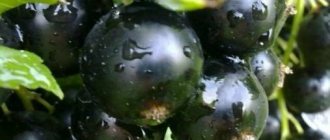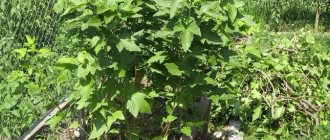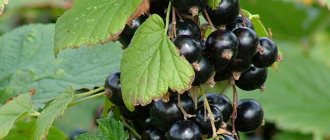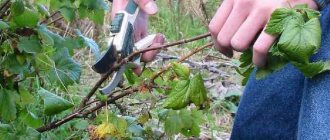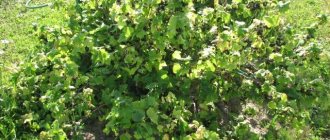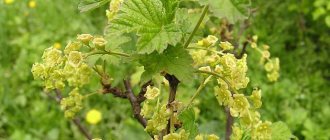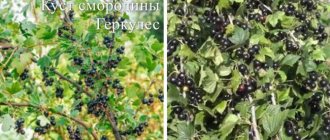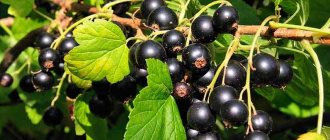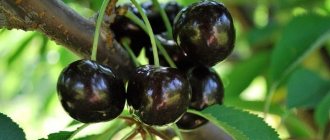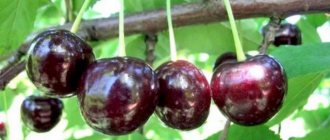Characteristics and description of the bush
This plant is characterized by a number of features. That is why summer residents often choose it to grow in their garden plots.
Habitat
The plant is recommended to be grown in the northwestern regions, in the central part of Russia. It is also actively planted in the Far East and the middle Volga.
Bush and fruits
This variety is characterized by spreading bushes. They are of medium height and dense. Young shoots are light green in color and have a curved top. Lignified branches have a characteristic bend and a gray-brown tint.
The leaves are five-lobed. They can be large or medium. The foliage has a green tint and a matte surface. The petioles are of medium length and thickness.
The flowers of the plant are medium in size and cup-shaped. They have a yellow-green tint. The brush reaches 10 centimeters and has medium density. Each of them bears 7 berries, which weigh 1.7-3 grams. The fruits are oval in shape and contain an average number of seeds.
Tasting assessment of berries and scope of application
Currants have a high tasting score - 4.5 points. The composition contains 8.1% sugars. 100 grams of berries contain 137.8 milligrams of ascorbic acid. Blackcurrant of this variety is distinguished by its versatility. Baked goods, preserves, jams, fruit drinks, jellies, and compotes are prepared from it.
Immunity to diseases
Currant Vologda has excellent immunity. Therefore, it is resistant to diseases and pests. The plant practically does not encounter powdery mildew, bud mites and other problems.
Resistance to frost and drought
The shrub is characterized by unique frost resistance. This allows it to be cultivated even in the northern regions. The plant tolerates dry weather well. However, in summer it is recommended to increase the number of waterings.
Harvest and storage
Black currant Vologda is a medium-late ripening variety. Flowering begins in mid-May. The berries ripen at the end of July and last for a month or two.
During the season, up to 4 kg of berries are harvested from one currant bush, which tolerate transportation well.
Ripe berries do not fall off until mid-September
At room temperature, the fruits are stored for only 2–3 days, after which they become soft and rot. To keep currants longer, they can be frozen, dried, ground with sugar, or used to prepare winter preparations.
The berries of this variety make tasty and healthy preparations for the winter.
The berries are dried in the oven at 45 °C. After they become lethargic, the temperature is increased to 70 °C. Drying time is 3–4 hours. It is important that the oven door is slightly open. The berries are also dried at room temperature. They are laid out on a baking sheet and left in a ventilated area, avoiding direct sunlight.
Frozen blackcurrant berries can be stored for several months. To do this, they are washed, dried, scattered in a thin layer on a tray and put in the freezer for 1.5 hours. When the berries are frozen, they are poured into plastic containers and stored in the freezer.
Black currant berries retain their beneficial properties even when frozen.
Advantages and disadvantages
Vologda variety currants have a number of advantages. This is an unpretentious variety that produces stable moderate yields. The bushes adapt well to different climatic conditions and are undemanding to care.
Vologda blackcurrant berries are large, juicy and tasty
pros
- versatility in use;
- high winter hardiness;
- resistance to certain diseases;
- good keeping quality and transportability;
- undemanding to soil composition.
Minuses
- average yield;
- needs watering;
- spreading of the bush.
Main characteristics of the variety
A description of the Vologda currant variety, photos, and reviews from gardeners will help you better study the culture. Let's start the review of characteristics with the structure of the bush. Currants grow with spreading branches. The bushes are medium-sized and very dense. The shoots grow with a bent tip. The skin is green. The bark of mature branches becomes gray with a brown tint. The five-pointed leaves on the bush grow in different sizes. The surface of the green plate is matte, and a bluish tint is often observed.
Flowers are collected in clusters. The length of the brush reaches 10 cm. The shape of the flowers resembles a saucer. The petals are yellow with a clear predominance of green. The stalk is purple. A bunch consists of an average of seven berries. Large fruits are located closer to the base. The weight of the berry varies from 1.7 to 3 g. A ripe cluster acquires a rich black color. The shape of the berries is round, slightly oval. The pulp contains many seeds. The skin is strong with slightly pronounced ribbing. The ripe berry is sweet, but the acidity is clearly felt. Vologda currant pulp contains vitamin C - 138 mg/100 g and sugar - 8.1%.
Pollination can occur without the participation of bees, since Vologda blackcurrant is self-fertile. In terms of ripening time, the variety is considered medium-late. The berries are ready to eat in early August. Brushes can hang on bushes for a long time. The berries do not crack even when overripe. The yield of the Vologda variety is 4 kg per bush. Currants have good winter hardiness.
Attention! Vologda blackcurrant bushes are afraid of temperature fluctuations. With frequent unfavorable natural phenomena, annual shoots and buds freeze out. 2
The advantages of black currant Vologda are the following features:
- winter resistance;
- slightly affected by ticks and powdery mildew;
- sweet large berries;
- stable yield;
- self-pollination;
- good adaptability to weather conditions.
One of the disadvantages of the Vologda variety is the large size of the bush, which is not comparable to the amount of harvest. The berries ripen unevenly, which is inconvenient when harvesting.
Important! When there is excess moisture, the skin of overripe berries tends to crack.
Planting seedlings
You can grow the Vologda blackcurrant variety in any area, even with poor soil. The shrub does not require special care. However, the Vologda variety has three worst enemies: constant shade, waterlogging of the bed, and rocky soil.
They have been planting seedlings since October. If night frosts in the region begin earlier, the dates are shifted to mid-September. A peculiarity of black currant is the absence of a dormant period in the root system. The Vologda seedling manages to take root in the fall, take root, and quickly grow in the fall.
In spring, Vologda seedlings are planted from March to April. The earth should thaw and warm up a little. The buds on the seedlings may be swollen, but not bloomed. The site for black currants is chosen to be damp, but not swampy. Usually Vologda bushes are planted in lowlands, along fences, but the place should be illuminated by the sun.
When purchasing, it is better to give preference to two-year-old seedlings from Vologda. The choice is made according to the structure of the root system. A good seedling has at least two woody brown roots with many thin threads extending off. A dark color indicates hypothermia or drying out of the root system. Such a seedling will disappear or take a long time to take root. The age of two-year-old seedlings is determined by the length of the root system, which is at least 15 cm.
Advice! Before purchasing, the Vologda seedling is removed from the pot. If the soil ball is heavily entwined with roots, the currant will quickly take root.
Seedlings 35 cm long with one or two shoots are considered good. The skin of healthy twigs is not wrinkled, brown in color without spots or mechanical damage.
When planting, maintain the permissible distance between seedlings and other objects:
- Vologda bushes grow spreading and take up a lot of space. The minimum distance between seedlings is 1.5 m.
- You can make a hedge from black currants of the Vologda variety. If bushes are planted along a fence, then maintain a minimum distance of 1.5 m.
- On large plantations, black currants of the Vologda variety are planted in rows. Since the bushes grow strongly, the row spacing is maintained at about 2.5 m. The path is needed for caring for the bushes, watering and harvesting.
- Blackcurrant bushes can be alternated with fruit trees. The distance between young plantings is maintained at least 2 m.
The rules for planting seedlings of the Vologda variety are the same as for other varieties. The whole process can be divided into several points:
- The area for seedlings is dug up using the bayonet of a shovel. Remove weed roots, large stones and check acidity. If the indicator is too high, scatter 500 g of lime per 1 m2, dig it up and leave it for a couple of days.
- Under each bush, holes are dug 40 cm deep. The hole can be made square or round, with a diameter of 50 cm.
- Half a bucket of compost and old manure is poured into the hole. Organics can be replaced with a mineral complex containing potassium, phosphorus and other trace elements.
- The contents of the hole are filled with a bucket of water. After absorption at the bottom of the hole, a slide is created from the soil.
- The Vologda currant seedling is installed at an angle of 45°. The root system is spread over the mound and covered with earth. The soil around the seedling is compacted by hand. This must be done carefully so as not to damage the root system.
- After planting, pour 4 buckets of water into the hole. The Vologda seedling is cut exactly in half with pruning shears. For currants with strong roots, it is fashionable to cut off 1/3 of the top part. Pruning creates optimal conditions for strong growth.
- The area around the seedling is framed with an earthen embankment. The soil in the hole is covered with a thick layer of sawdust or peat mulch.
Swampy areas with close groundwater can also be used for growing black currants. No holes are dug in such areas. After digging up the ground and applying fertilizing, wide mounds 25 cm high are made. Currant seedlings are planted on them.
Advantages and disadvantages of culture
The main advantages of the plant include the following:
- Strong immunity. The culture adapts to any climate.
- Good resistance to frost. The plant easily tolerates even a strong drop in temperature.
- Undemanding to soil composition. The exception is rocky and marshy soil.
- Resistance to major diseases and pests.
- Excellent transportability. If harvested correctly, the fruits can be stored for a long time.
- Versatility. The berries can be eaten fresh or processed. They are boiled, frozen, canned. At the same time, the fruits retain maximum benefits.
See also
Description and characteristics of the Gulliver currant variety, planting and care
Read
The disadvantages of the variety include the non-simultaneous ripening period. As a result, the berries may crack when overripe. Also, a disadvantage of the plant can be its very spreading crown, which takes up a lot of space in the garden.
Features of care
Black currants require careful care immediately after planting so that the seedlings take root well and give rapid growth. If you continue to take care of adult bushes, the Vologda variety will reward you with a good harvest.
Currants need water as a source of moisture and as a preventative measure. In early spring, the bushes are given a hot shower. Heat a bucket of water to a temperature of 60–70°C, dissolve 250 g of baking soda, pour it into a watering can and irrigate the bush. The hot solution is safe for currants, but destroys overwintering pests on the branches.
Vologda currants love moisture, but frequent watering is not needed. There is enough dampness inside the soil. Watering can be increased more frequently in dry summers, when the intense heat causes cracks to appear on the ground. Under each currant bush, a deep depression is raked and up to 6 buckets of water are poured. The ground should get wet to a depth of 40 cm.
Mandatory watering is carried out in the following cases:
- in the spring before the buds open, if the weather is dry outside;
- during flowering and berry filling;
- dry summer;
- in the fall, when the currants shed their leaves.
Many gardeners resort to the simplest method of watering - sprinkling. Splashes of water wash away dust well from currant foliage, but greatly compact the soil. To ensure uniform and deep absorption of moisture, grooves 10 cm deep are cut on the soil surface in the expected root area.
A good effect is obtained from a stone well. Under a blackcurrant bush I dig a hole 40 cm deep and 25 cm wide. Large stones are thrown into the hole. During watering, water quickly passes through the stones and reaches the roots. The top of the stone well is covered with a piece of tin or roofing felt to prevent moisture evaporation.
Important! In winter, the stone well is covered with a thick layer of straw or other insulation to prevent the roots from freezing.
Soil care includes loosening, weeding, adding wood ash and mulching. Vologda black currant responds well to fertilizing. Fertilizers are applied in the third year after planting the seedling:
- in the fall, after dropping the leaves, 3 kg of organic matter is added under the bush;
- Every year, mineral fertilizers are added along with organic matter: 30 g of nitrogen and phosphorus, as well as 15 g of potassium;
- while pouring berries under the bush, add potassium dissolved in water - 10 g and superphosphate - 40 g;
- in spring, during flowering and after harvesting, currants are fed with urea at the rate of 40 g per bush.
The first pruning of a young Vologda seedling is carried out immediately after planting. By autumn, five shoots about 45 cm long should grow. Next year there will be new growth. Old branches will give birth, and only strong ones will leave new shoots. All weak branches are cut off. In the third year, last year's shoots become fruit bearing. Old branches also bear fruit, but they are cut off in the fall. The further pruning cycle is repeated annually. An adult, normally formed bush should consist of 10–15 fruit branches.
Diseases and pests
The Vologda variety is resistant to powdery mildew and bud mite.
In order for black currants to produce a good harvest for many years, you need to timely treat them from diseases and pests.
Protection of currants from pests and diseases - table
| Name of disease/pest | Symptoms | Processing period | Control measures | Prevention |
| Anthracnose | Small brown spots appear on the leaves. With severe damage, the spots merge, changing the color of the leaf, after which it dries out and falls off. | Before the buds open. | The bushes are treated with 1% Bordeaux mixture (100 g per 10 liters of water). | The bushes and soil are treated with copper sulfate (100 g per 10 liters of water). |
| Glass rust | Leaves, flowers and ovary are covered with yellow pads. |
| Spraying the bushes with 1% Bordeaux mixture (100 g per 10 liters of water). In case of severe damage, another treatment is required 10 days after the third. | Treatment with fungicide (Previkur, Skor, Fitosporin-M, Topaz) according to the instructions. |
| Powdery mildew | A white coating forms on the leaves, looking like a fine cobweb. | In the spring before the buds open. | The bushes are sprayed with a 2% nitrafen solution. | Infuse 1.5 kg of ash in a bucket of water for 24 hours. Strain and dissolve 50 g of laundry soap. Treat the bushes in dry, windless weather. |
| Terry | The leaves change, they stretch out and take on an asymmetrical shape, and the bush loses its aroma. | After picking berries. | After picking the berries, the bushes are sprayed with a solution of colloidal sulfur. | Timely application of potassium-phosphorus fertilizers to increase resistance to the disease. |
| Kidney mite | The buds on the bushes swell. This is especially noticeable after leaf fall. | Before the buds open. | Buds or branches are cut off and burned. In case of severe damage, the entire bush is destroyed. | Timely pruning and weeding. |
| Ognevka | The berries are damaged and shrouded in cobwebs. |
| Spraying with Karbofos (5 g per 10 liters of water). Berries damaged by the pest are picked and burned. |
|
| Glassware | Damages leaves, flowers and berries. | After the buds open. | The bushes are sprayed with solutions of onion peels, pine needles or wormwood. | The needles and wormwood are laid out in the center of the bushes. |
Diseases and pests of black currant in the photo
The yield of shoots damaged by glass is reduced from 55 to 95%
Blackcurrant buds infected with mites are very different from healthy ones
The moth is the most dangerous pest of currants
Powdery mildew usually appears in the first half of June
It can take up to four years from currant infection to the appearance of the first signs of terry disease.
The causative agent of glass rust is a parasitic fungus
The causative agent of currant anthracnose overwinters on fallen leaves
Important! Blackcurrant bushes are processed no later than 30 days before harvest.
Currant propagation
To propagate currants, arcuate layering is very often used, and even more often, green or woody cuttings. Two-year-old branches that are simply pruned from a bush are also well suited for propagation.
These methods are perfect for black currants, but it is better not to propagate red currants by cuttings. Layerings are most suitable for breeding red currants.
As for growing currant bushes from seeds, it is simply unrealistic to do this on an ordinary plot; it is not even worth spending your time and effort on it. Only breeders engage in this method, because it is a very complex and long process that can take more than one year.
Currants can be propagated by both green and woody cuttings. Woody cuttings are used much more often than green ones because they can be prepared for future planting at absolutely any time.
You can plant cuttings not only in autumn, but also in spring. Experienced gardeners recommend that beginners prepare cuttings for planting during the first frost. The length of the cutting for planting should be up to 20 cm long and up to 1 cm thick.
It is recommended to cut cuttings from the middle of 3 summer branches. But in order to ensure that all the moisture does not evaporate from the cut cuttings during their storage before planting and they do not disappear, the place where the cuttings are cut must be covered with garden varnish. This needs to be done both on the bush and on the cutting itself.
After that, the cuttings, one at a time, need to be wrapped in damp paper and placed in a plastic bag and put the whole thing in a cool place. In early spring, the cuttings need to be taken out and planted in the beds.
They are planted in the same way as seedlings on a slope, and the distance between the cuttings should be approximately 20 cm, and the width should be the same. But when you plant a cutting, the place that you previously covered with garden varnish needs to be cut at an angle.
After planting, the cuttings must be thoroughly watered and mulched. To do this, you can use anything, peat, sawdust, humus, etc. It is best to place arcs over the bed with cuttings and cover it with film.
The film is removed only when the cuttings have leaves. All this time, the bed must be regularly watered and ensure that the soil does not dry out. Throughout the summer, the cuttings need to be watered, weeded and fed with mullein.
Soon the cuttings will turn into seedlings and with the onset of autumn the strongest ones are transplanted to a permanent place, and those seedlings that turn out to be weak should be left in the garden until next autumn.
In order to root currants with green cuttings, you need a greenhouse. Cuttings should only be taken from properly developed shoots and the tip of the shoot should not be rooted. The green cutting must be cut to a length of no more than 15 cm and must have at least two leaves.
In order for the cuttings to develop roots, they need to be placed in a small container with water for some time until the roots grow at least 2 cm long. After they have formed roots, the cuttings need to be planted in bags.
But don’t forget to make holes in the bottom of the bags so that when watering, excess liquid can easily escape. When planting this way, cuttings need to be watered only once every 2 days. And 10 days after planting, watering should be reduced to once a week.
The cuttings should be kept at home on the windowsill until May, at which time they grow up to half a meter. In May, the cuttings are transplanted into open ground 15 cm deeper than they originally grew in the bag. The roots of the plant must be completely in the ground, so when transplanting the bag you just need to cut it.
It is even easier to propagate a currant bush simply by layering. With this type of planting, the root system of the bush will be fully formed within a year after transplantation. In order to transplant cuttings, you need to choose a branch that is already 2 years old.
It must be absolutely healthy, and from the bush this branch must grow at an angle. Under this branch you need to make a furrow no more than 10 cm deep, and the branch itself needs to be carefully bent and placed there.
But you must remember that the top of the branch must be above the ground, and the branch itself must be fixed in the ground. Layers located in the ground need to be watered periodically. This is done so that the root system becomes stronger by autumn and the seedling itself is fully developed.
After the cutting is ready, it needs to be cut from an adult bush and transplanted to a permanent place.
Choosing a place and time of landing
Black currant Vologda prefers lowlands. In this case, the humidity must be very high! It is important to choose a place in the sun, and the plant must be protected from the wind. By the way, gardeners often place Vologda along the fence.
The root system of this variety of currants does not have a dormant period, that is, over the winter the shrub will have time to take root, and by spring it will begin active growth! Therefore, it is worth planting Vologda seedlings at the end of September - October, about a month before the cold weather. If the deadlines are missed, black currants need to be planted at the very beginning of April, before the buds begin to bloom.
Planting Vologda: step-by-step instructions
In order for the seedlings to take root, grow well and bring a large harvest, you need to follow certain rules for planting them in the soil.
- The place chosen for currants must be carefully dug up, debris and weeds removed. This shrub does not tolerate highly acidic soils, and therefore, if such a problem exists, it is necessary to add lime to the soil - half a kilogram per 1 sq. m. m.
- The depth of the planting hole should be about 40 cm and the diameter 60 cm.
- At the bottom of the prepared hole you need to pour 0.5 buckets of compost and the same amount of rotted manure. The latter can be replaced with fertilizer: 20 grams of potassium, 200 grams of superphosphate and 40 grams of phosphorus.
- Then the hole needs to be watered generously.
- The shoot must be installed in the hole at an angle of 45 degrees, and its root system must be straightened. This tilt will allow you to form a stronger bush.
- Gardeners recommend covering Vologda with soil and compacting it a little.
- You need to carefully pour three or four buckets of water under the planted bush.
- Immediately after planting, the bush should be pruned. If the root system is strong, you can cut it by a third, but if the roots are weaker, it’s better to cut it by half. This will allow you to get a good increase in the first year.
- To prevent the plant from drying out, you need to form a hole around the bush, which is mulched with dry grass, peat or sawdust.
Top dressing
The late variety of black currant Vologda requires fertilization. Insufficient nutrients will cause the fruits to become small and sour, and the yield will be significantly reduced. Fertilizers applied during planting will only last for a couple of years. Starting from the third year, Vologda needs to be fed. How to fertilize this plant?
- Mineral fertilizers should be applied every autumn. For 1 sq. m will need 30 g of phosphorus and nitrogen fertilizers, 15 g of potash.
- Organic fertilizers are also applied in the fall, immediately after leaf fall. For 1 sq. m will need 2-3 kg of feeding.
- Phosphate-potassium fertilizers are required immediately after currants bloom.
- Vologda needs nitrogen fertilizers three times a year - immediately after the snow melts, during flowering and immediately after picking berries.
Black currant variety Vologda: reviews from gardeners
Professionals and amateurs recommend this variety to those who do not want to spend a lot of time and effort on caring for the plant. Vologda survives in any conditions, and its immune system allows you to enjoy delicious fruits without much effort.
By the way, many gardeners admit that they plant Vologda on their site as an ornamental shrub. This has a certain meaning: the heavy black clusters shimmer in the sun, and the carved currant foliage is beautiful.
If you believe reviews about black currants, Vologda has good reproduction ability. Young shoots not only take root easily, but also do not harbor pests.
